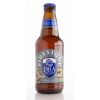Firestone Walker Brewing Company - Double Barrel Ale
-
ABV:
5.0% -
Int’l Bittering Units (IBUs):
34 -
Serving Temperature:
42-47° F

Tucked away in the lush vineyards of Los Olivos, California, is the Firestone Walker Brewing Company. Adam Firestone, the president of the Firestone Vineyard, and his brother-in-law, David Walker, teamed up to bring a literal "pipe-dream" into reality. Faced with a serious grape shortage that occurred on California's South Central Coast in 1995, Firestone and Walker put an idea into action, expanding the successful and well-known winery to include an age-old beer brewing process.
Adam Firestone says that his father was the first to experiment with brewing a high-quality non-alcoholic beer in 1987 amid a rise in popularity of that product. The elder Firestone purchased equipment and adapted winemaking vessels for beer fermentation and conditioning, but ultimately determined that sales of non-alcoholic beer did not justify continuing the operation, so it was abandoned in 1990. All efforts at the Firestone Vineyard returned to a concentration on providing quality wines to meet the demand of their discerning customers. It was not until the drastically small crop of grapes in 1995 that the thought of brewing beer once again moved into the spotlight.
At first, Firestone and Walker tried using some empty Chardonnay barrels for fermentation. The wine makers soon discovered that too much oxidation and contamination would require a fresh approach to create the brew they desired. They then hired brewmaster Jeffers Richardson, who suggested that they try using an old British brewing method called the Burton Union system, which is rarely used today. Connecting a series of new, cleaner American oak barrels in a closed system, Firestone and Walker were able to adapt the process to create the Firestone Union. The 60-gallon barrel typically used in winemaking proved to be unexpectedly advantageous, as the smaller volume-to-surface area helped maintain a constant temperature. Historically, brewers using the union systems complained that differing ambient temperatures produced inconsistent flavors.
Firestone Walker begins fermentation in a large primary fermenter, which, at peak yeast growth, transfers a percentage to the Firestone Union where fermentation and cleansing occur. All of the beer is then blended in the conditioning tank. There, the flavors from the oak barrel fermentation marry with the beer from the primary fermenter. Additional fining and oak aging help clarify and stabilize each brew. This unique "double barrel" process produces Firestone Walker's truly satisfying Double Barrel and Windsor Pale ales. For more information about the brewery and tours, call 805-688-3940.
For more information about the brewery and scheduled tours, call (805) 688-3940 or check out their web site at www.firestonewalker.com.
Adam Firestone says that his father was the first to experiment with brewing a high-quality non-alcoholic beer in 1987 amid a rise in popularity of that product. The elder Firestone purchased equipment and adapted winemaking vessels for beer fermentation and conditioning, but ultimately determined that sales of non-alcoholic beer did not justify continuing the operation, so it was abandoned in 1990. All efforts at the Firestone Vineyard returned to a concentration on providing quality wines to meet the demand of their discerning customers. It was not until the drastically small crop of grapes in 1995 that the thought of brewing beer once again moved into the spotlight.
At first, Firestone and Walker tried using some empty Chardonnay barrels for fermentation. The wine makers soon discovered that too much oxidation and contamination would require a fresh approach to create the brew they desired. They then hired brewmaster Jeffers Richardson, who suggested that they try using an old British brewing method called the Burton Union system, which is rarely used today. Connecting a series of new, cleaner American oak barrels in a closed system, Firestone and Walker were able to adapt the process to create the Firestone Union. The 60-gallon barrel typically used in winemaking proved to be unexpectedly advantageous, as the smaller volume-to-surface area helped maintain a constant temperature. Historically, brewers using the union systems complained that differing ambient temperatures produced inconsistent flavors.
Firestone Walker begins fermentation in a large primary fermenter, which, at peak yeast growth, transfers a percentage to the Firestone Union where fermentation and cleansing occur. All of the beer is then blended in the conditioning tank. There, the flavors from the oak barrel fermentation marry with the beer from the primary fermenter. Additional fining and oak aging help clarify and stabilize each brew. This unique "double barrel" process produces Firestone Walker's truly satisfying Double Barrel and Windsor Pale ales. For more information about the brewery and tours, call 805-688-3940.
For more information about the brewery and scheduled tours, call (805) 688-3940 or check out their web site at www.firestonewalker.com.

Unmatched Variety by style, brewery & country
Choose from Five different Beer Clubs offering unmatched variety by brewery,
country of origin, and beer style to suit your specific tastes.


